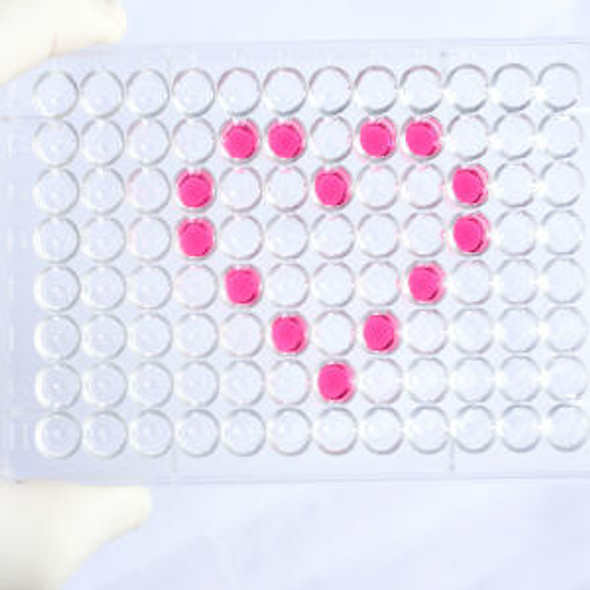Description
| Product Name: | Human HMGA2 Recombinant Protein |
| Product Code: | RPPB3696 |
| Size: | 10µg |
| Species: | Human |
| Target: | HMGA2 |
| Synonyms: | High Mobility Group AT-Hook 2, HMGIC, High-Mobility Group(Nonhistone Chromosomal) Protein Isoform I-C, High Mobility Group AT-HookProtein, BABL, HMGI-C, LIPO, STQTL9, High Mobility Group Protein HMGI-C,HMGA2. |
| Source: | Escherichia Coli |
| Physical Appearance: | Sterile Filtered clear solution. |
| Formulation: | HMGA2 protein solution (0.25mg/ml) containing 20mMTris-HCl buffer (pH 8.0), 0.2M NaCl, 50% glycerol, 2mM DTT and 250mM Imidazole. |
| Stability: | Store at 4°C if entire vial will be used within 2-4 weeks. Store, frozen at -20°C for longer periods of time. For long term storage it is recommended to add a carrier protein (0.1% HSA or BSA).Avoid multiple freeze-thaw cycles. |
| Purity: | Greater than 80.0% as determined by SDS-PAGE. |
| Amino Acid Sequence: | MSARGEGAGQ PSTSAQGQPA APAPQKRGRG RPRKQQQEPT GEPSPKRPRG RPKGSKNKSP SKAAQKKAEA TGEKRPRGRP RKWPQQVVQK KPAQEETEET SSQESAEEDL EHHHHHH |
High Mobility Group AT-Hook 2 (HMGA2) is a member of the non-histone chromosomal high mobility group (HMG) family. HMG proteins perform as architectural factors and are necessary components of the enhancesome. This protein contains structural DNA-binding domains and may function as a transcriptional regulating factor. In addition, identification of the deletion, amplification, and rearrangement of this gene that are associated with myxoid liposarcoma proposes a role in adipogenesis and mesenchymal differentiation. A gene knock out study of the mouse counterpart demonstrated that this gene is implicated in diet-induced obesit. Among the Diseases associated with HMGA2 are diffuse lipomatosis, and 12q14 microdeletion syndrome.
HMGA2 Human Recombinant produced in E.Coli is a single, non-glycosylated polypeptide chain containing 117 amino acids (1-109 a.a) and having a molecular mass of 12.8kDa.HMGA2 is fused to an 8 amino acid His-tag at C-terminus & purified by proprietary chromatographic techniques.
| UniProt Protein Function: | HMGA2: Functions as a transcriptional regulator. Functions in cell cycle regulation through CCNA2. Plays an important role in chromosome condensation during the meiotic G2/M transition of spermatocytes. Interacts with E4F1. Interacts with NEK2. Belongs to the HMGA family. 2 isoforms of the human protein are produced by alternative splicing. |
| UniProt Protein Details: | Protein type:DNA-binding; Oncoprotein Chromosomal Location of Human Ortholog: 12q15 Cellular Component: nucleoplasm; nuclear chromosome; nucleus Molecular Function:protein binding; nucleosomal DNA binding; DNA-(apurinic or apyrimidinic site) lyase activity; DNA binding; AT DNA binding; DNA-dependent protein kinase activity; 5'-deoxyribose-5-phosphate lyase activity; SMAD binding; DNA bending activity; transcription factor binding Biological Process: fat cell differentiation; establishment and/or maintenance of chromatin architecture; positive regulation of apoptosis; multicellular organismal development; positive regulation of transcription, DNA-dependent; mesodermal cell differentiation; negative regulation of transcription from RNA polymerase II promoter; regulation of transcription, DNA-dependent; base-excision repair; regulation of growth; chondrocyte differentiation; negative regulation of retroviral genome replication; mitosis; transcription, DNA-dependent; heterochromatin formation; response to virus; DNA damage response, detection of DNA damage; stem cell differentiation; DNA catabolic process, endonucleolytic; negative regulation of DNA binding; chromosome condensation; mesenchymal cell differentiation; cell division; mitotic cell cycle G2/M transition DNA damage checkpoint; chromosome breakage; epithelial to mesenchymal transition; positive regulation of transcription from RNA polymerase II promoter; negative regulation of transcription, DNA-dependent; negative regulation of apoptosis Disease: Leiomyoma, Uterine |
| NCBI Summary: | This gene encodes a protein that belongs to the non-histone chromosomal high mobility group (HMG) protein family. HMG proteins function as architectural factors and are essential components of the enhancesome. This protein contains structural DNA-binding domains and may act as a transcriptional regulating factor. Identification of the deletion, amplification, and rearrangement of this gene that are associated with myxoid liposarcoma suggests a role in adipogenesis and mesenchymal differentiation. A gene knock out study of the mouse counterpart demonstrated that this gene is involved in diet-induced obesity. Alternate transcriptional splice variants, encoding different isoforms, have been characterized. [provided by RefSeq, Jul 2008] |
| UniProt Code: | P52926 |
| NCBI GenInfo Identifier: | 1708263 |
| NCBI Gene ID: | 8091 |
| NCBI Accession: | P52926.1 |
| UniProt Related Accession: | P52926 |
| Molecular Weight: | |
| NCBI Full Name: | High mobility group protein HMGI-C |
| NCBI Synonym Full Names: | high mobility group AT-hook 2 |
| NCBI Official Symbol: | HMGA2�� |
| NCBI Official Synonym Symbols: | BABL; LIPO; HMGIC; HMGI-C; STQTL9�� |
| NCBI Protein Information: | high mobility group protein HMGI-C |
| UniProt Protein Name: | High mobility group protein HMGI-C |
| UniProt Synonym Protein Names: | High mobility group AT-hook protein 2 |
| Protein Family: | HMG2-induced ER-remodeling protein |
| UniProt Gene Name: | HMGA2�� |
| UniProt Entry Name: | HMGA2_HUMAN |






